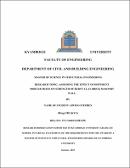| dc.contributor.author | Owino, Stephen | |
| dc.date.accessioned | 2022-03-15T11:15:09Z | |
| dc.date.available | 2022-03-15T11:15:09Z | |
| dc.date.issued | 2019-10 | |
| dc.identifier.citation | Owino, Stephen (2019). Assessing the effect of different mortar mixes on strength of burnt clay brick masonry wall.Kyambogo University(Unpublished work) | en_US |
| dc.identifier.uri | https://kyuspace.kyu.ac.ug/xmlui/handle/20.500.12504/870 | |
| dc.description | xiv,111 p. : col. | en_US |
| dc.description.abstract | Following the tremendous increase in population growth rate in Uganda from 12.6 million
people in 1980 to 34.6 million people in 2014, there has been an increase in housing units
from 2.6 million house in 1980 to 7.34 million houses in 2014. Despite of this increase in
housing units, the population has surpassed the demand leading to a deficit of 200, 000
housing units annually. The National Housing and population census of 2014 revealed that the
increased housing units is constructed of permanent materials at 43.7% with burnt clay
bricks leading at 36.4% followed by mud and poles at 33.6% and these are materials used
without the knowledge of their strength and properties. Hence, the need to assess its strength
so as to protect the inhabitants against accidents and loss of lives. Research findings indicated
that 100% of the structural design firms do not design masonry structures made of burnt clay
bricks but instead specify them as infills. 100% survey on 102 sites established that the
commonly used mortar mix ratios range between 1:7 to 1:14 far different from the perceived
mortar mix ratios of 1:3 to 1:6 as a result of the use of one bag of cement to a number of
wheelbarrows and these resulted into a compressive strength of 5.92N/mm2 to 1.87N/mm2
respectively far below the intended compressive strength of 17.8N/mm2 to 6.82N/mm2.
Experimental tests on burnt clay bricks has established varying compressive strength with an
average of 7.3N/mm2 to 2.06N/mm2 and this was attributed to water absorption, method of
manufacture and the soil type. Results on burnt clay masonry walls constructed of most used
mortar mix ratios established that , the compressive strength of the wall greatly reduced with
increasing value of mortar mix ratios. Conclusively, the wall strength was much influenced by
the strength of mortar, indicating that the weaker the strength of mortar the weaker the wall
strength and vice versa however strong the brick may be, hence high mix ratios beyond 1:6
should not be used in the construction of masonry clay brick walls to avoid structural failures. | en_US |
| dc.language.iso | en | en_US |
| dc.publisher | Kyambogo University(Unpublished work) | en_US |
| dc.subject | Mortar mixes | en_US |
| dc.subject | Clay bricks masonry wall | en_US |
| dc.subject | Burnt clay brick strength | en_US |
| dc.subject | Masonry wall strength | en_US |
| dc.title | Assessing the effect of different mortar mixes on strength of burnt clay brick masonry wall | en_US |
| dc.type | Thesis | en_US |

